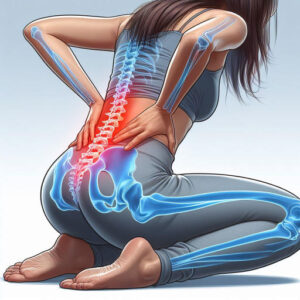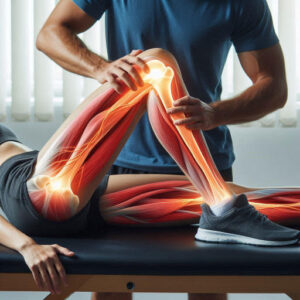Sciatica has the potential to affect millions of people worldwide and significantly influence people’s daily lives. Beginning in the lower back, it radiates down the leg, causing tingling, numbness, and discomfort. To correctly manage and treat sciatica, one must know the condition’s causes, symptoms, and diagnosis. People with excellent knowledge about this condition can better control their symptoms and improve their health.
Key Takeaways
- Sciatica results from compression or irritation of the sciatic nerve, which causes pain, numbness, and weakness in the lower back, buttocks, and legs.
- Early treatment for sciatica pain is essential to prevent the condition from worsening and causing long-term damage to the nerve.
- Medications such as pain relievers, muscle relaxants, and corticosteroids can provide temporary relief for sciatica pain but may also have side effects.
- Physical therapy and exercise can help alleviate sciatica pain by improving flexibility, strength, and posture.
- Chiropractic care may relieve sciatica pain, but its effectiveness is still debated among medical professionals.
Understanding Sciatica: Causes, Symptoms, and Diagnosis
 It is possible to develop sciatica due to compression or irritation of the sciatic nerve, which begins in the lower back and travels down the leg. Several causes, including spinal stenosis, ruptured discs, or muscular imbalances, can cause this compression. One symptom of a compressed nerve is a lack of sensation or tingling in the lower back or legs.
It is possible to develop sciatica due to compression or irritation of the sciatic nerve, which begins in the lower back and travels down the leg. Several causes, including spinal stenosis, ruptured discs, or muscular imbalances, can cause this compression. One symptom of a compressed nerve is a lack of sensation or tingling in the lower back or legs.
A herniated disc forms when the inner, softer disc material presses on the nerve roots through the outer, more complicated disc layer. This is a typical cause of sciatica. Another potential cause of sciatica is spinal stenosis, which manifests as a constriction of the spinal canal. Additional factors that might lead to sciatica include poor posture, excess body fat, and muscle imbalances.
When diagnosing sciatica, imaging studies, physical tests, and nerve conduction testing are usually combined. During a physical examination, a medical practitioner assesses the patient’s reflexes, strength, and mobility. The doctor may recommend imaging tests, such as X-rays or MRIs, to check the spine for structural issues. If you have any suspicions about nerve damage or dysfunction, a nerve conduction study might be useful in ruling it out.
The Importance of Early Treatment for Sciatica Pain
Therapy should start right away to help with sciatica pain and prevent it from getting worse. If you delay treatment, your symptoms may worsen or perhaps cause irreversible nerve damage. If people get treatment as soon as they notice symptoms, it can improve their quality of life and reduce their discomfort.
Various options for treating sciatica include pharmacological, physiotherapeutic, chiropractic, and surgical approaches. Pain and inflammation can be alleviated using muscle relaxants and NSAIDs. Physical treatment for sciatic nerve pain involves stretching and strengthening the muscles surrounding the spine to reduce joint stiffness and pain. As part of its mission to realign the spine and alleviate nerve compression, chiropractic treatment includes spinal manipulation and mobilisation treatments. Severe compression of the sciatic nerve may necessitate surgical intervention.
Medications for Sciatica: Pros and Cons
It is common practice to use medication to reduce sciatica-related inflammation and discomfort. Common nonsteroidal anti-inflammatory drugs (NSAIDs) that can relieve pain and inflammation include ibuprofen and naproxen. When muscle spasms are a part of your sciatica symptoms, your doctor may suggest using a muscle relaxant.
Medication may temporarily relieve symptoms but comes with risks and side effects. The risk of stomach ulcers, kidney problems, and cardiovascular disease increases with the long-term or excessive use of nonsteroidal anti-inflammatory drugs (NSAIDs). Constipation, drowsiness, and dependence are side effects of long-term use of muscle relaxants.
Finding the best medication regimen for individual needs requires close cooperation with a healthcare provider. In addition to looking for side effects, they can assess the severity of symptoms and consider any underlying medical conditions or medications.
 Physical Therapy and Exercise for Sciatica Pain Relief
Physical Therapy and Exercise for Sciatica Pain Relief
Physical treatment is necessary to strengthen the muscles surrounding the spine and increase flexibility, reducing the discomfort of sciatica. To improve and address any imbalances or weak areas, you may engage with a physical therapist to develop a personalised exercise plan.
Hamstring stretching is a typical workout for sciatica pain relief because it reduces pressure on the sciatic nerve. Strengthening abdominal and back muscles may result in several benefits, including improved spinal stability and less strain on the lower back. Fitness and recovery can be aided by low-impact aerobic exercises like swimming or walking.
Working with a physical therapist ensures that workouts are executed correctly and safely. They can assist you with form correction, progress tracking, and programme tweaking.
Chiropractic Care for Sciatica: Does it Work?
Non-invasive spinal correction with chiropractic care can alleviate back pain and pinched nerves. Spinal manipulation and mobilisation are two techniques chiropractors use to correct spinal deformities and improve spinal health.
Chiropractic care is effective in reducing sciatica symptoms. The Journal of Manipulative and Physiological Therapeutics found that individuals with acute sciatica experienced superior pain relief and functional improvement after chiropractic adjustments compared to medication.
Most patients have no adverse side effects when treated by a qualified chiropractor. But, due to health problems or spinal abnormalities, some people may not be able to benefit from chiropractic treatment. You should see a doctor to ensure proper chiropractic care before starting treatment.
Acupuncture and Massage Therapy for Sciatica Pain
Sciatica sufferers may find relief through alternative pain management techniques like massage and acupuncture. These techniques reduce muscular tension, boost blood flow, and soothe the neurological system.
It is believed that acupuncture, an alternative medicine, can hasten the healing process by manipulating the body’s energy channels through the judicious placement of highly tiny needles. According to Stuthe Dies, acupuncture potentially reduces pain and improves functional capacities. An experiment published in the Journal of Traditional Chinese Medicine suggested that acupuncture was more effective than medication in relieving sciatica pain.
Massage therapy is a form of physical manipulation of soft tissues that aims to increase blood flow and decrease muscle tension. It may be a wonderful method to relax and alleviate discomfort for those who experience sciatica. The Journal of Bodywork and Movement Therapies reports that people with sciatica or other chronic lower back pain get relief and improved function after receiving massage therapy.
Find a registered massage therapist or acupuncturist who specialises in treating sciatica. Based on their findings, these experts can assess your condition and provide a unique treatment strategy to ease your pain.
 Natural Remedies for Sciatica: Herbs, Supplements, and Essential Oils
Natural Remedies for Sciatica: Herbs, Supplements, and Essential Oils
Natural therapies can be combined with conventional treatments to help reduce sciatica pain. Some herbs, vitamins, and essential oils have analgesic and anti-inflammatory properties that help alleviate symptoms.
Turmeric contains the spice curcumin, which has anti-inflammatory effects. Whether taken orally or cooked, turmeric may help reduce inflammation and alleviate sciatica pain.
The element magnesium aids in muscular relaxation and the regulation of nerve impulses. Magnesium pills or topical magnesium oil can help ease muscular tension and nerve discomfort.
Essential lavender oil has long been a favourite due to its calming and analgesic properties. Lavender oil can be used topically or in a warm bath to alleviate muscle tension or sciatica pain.
Natural remedies can be helpful, but before using them on their own, anybody should see their doctor, especially if they have any preexisting conditions, are on any medications, or have any other health issues. They can look for side effects, provide advice on the right dosage, and spot drug combinations.
Surgery for Sciatica: When is it Necessary?
Surgical procedures may be considered when non-invasive treatments for sciatica fail or when severe nerve compression or damage is identified. These procedures are carried out to identify and remove the source of sciatic nerve compression, alleviating the discomfort.
Sciatica relief surgery options include discectomy, laminectomy, and spinal fusion. When a herniated disc pushes on a nerve, a discectomy may be required to remove some of the damaged tissue. One way to relieve pressure on the nerve is to remove part of the bony spine arches, which is called a laminectomy. Spinal fusion is performed by fusing two or more vertebrae to stabilise the spine and alleviate stress on the nerves.
While surgery does provide significant relief for some patients, it is not risk-free. Some of the potential consequences include infection, nerve damage, bleeding, and failed back surgery syndrome. You should talk to a doctor and weigh the benefits and risks of surgery before making a final decision.
Lifestyle Changes to Manage Sciatica Pain
A combination of medicine and changes to your daily routine can manage your sciatica pain and keep it from worsening. It is critical to maintain a healthy weight since being overweight increases the risk of back disorders and strains the spine. Regular exercise can also benefit your spine by making it more flexible and strengthening the muscles around it. Good posture and ergonomic furniture can also help relieve strain on the lower back.
Stress can exacerbate sciatica symptoms, such as muscle tension and discomfort; therefore, people with this illness must learn to control their stress. Integrating stress-reduction and health-enhancing techniques into one’s daily life is possible through yoga, meditation, or deep breathing.
 Preventing Sciatica: Tips for a Healthy Spine and Nervous System
Preventing Sciatica: Tips for a Healthy Spine and Nervous System
Prioritising prevention is crucial in managing sciatica. Taking good care of their spine and neurological system can reduce the likelihood of experiencing sciatica or having recurrent episodes.
Maintaining a healthy spine and warding off muscle imbalances requires consistent training. Engaging in activities that increase your strength, flexibility, and capacity to maintain excellent posture may reduce your risk of sciatica. A varied exercise programme that includes aerobics, weight training, and stretching is essential.
Good ergonomics are also crucial for avoiding sciatica. Using proper form when lifting heavy objects, maintaining a straight posture while sitting or standing, and utilising ergonomic furniture that contours the spine’s natural curve are all part of this.
While sciatica may significantly impact daily life, there is hope for those who suffer from it. They can alleviate pain and improve their well-being with the correct information and support. Successful management of sciatica pain and prevention of its worsening is possible via early therapy, investigation of various treatment alternatives, and adoption of lifestyle improvements. A person’s needs, desires, and objectives can be better met when they work closely with healthcare providers to develop a personalised treatment plan. Preventative pain treatment for sciatica can improve health and quality of life.
If you’re seeking a solution to your sciatica pain, consider high-intensity laser therapy. This novel approach to pain relief and wound healing has demonstrated encouraging outcomes. A new post on the MCR Therapies website delves into the advantages of high-intensity laser treatment for pain reduction. Learn how this innovative therapy can help reduce your sciatica pain! … Check out the article here.
MCR Therapies also offers other alternative therapies, such as cupping therapies, which have been known to unveil the mysteries of pain relief. To explore the wonders of cupping treatments, you can read their informative article here. Stay informed and up-to-date with the latest news and developments in pain management by visiting MCR Therapies’ news section here.
FAQs
What is sciatica pain?
Sciatica is a type of pain that occurs along the sciatic nerve, the longest nerve in the body. It usually starts in the lower back and extends to the legs and feet.
What causes sciatica pain?
A herniated disc, spinal stenosis, or degenerative disc disease usually causes sciatica pain. Other causes include pregnancy, muscle spasms, and spinal tumours.
What are the symptoms of sciatica pain?
Sciatica pain symptoms include pain in the lower back, buttocks, legs, and feet. It can also cause numbness, tingling, and weakness in the affected area.
How is sciatica pain diagnosed?
Sciatica pain is usually diagnosed through a physical examination and medical history. Imaging tests such as X-rays, MRIs, and CT scans may also be used to confirm the diagnosis.
What are the treatment options for sciatica pain?
Physical therapy, pain medication, and surgery are treatment options for sciatica pain. Other treatments, such as acupuncture, chiropractic care, and massage therapy, may also be helpful.
How can I prevent sciatica pain?
To prevent sciatica pain, it is crucial to maintain good posture, exercise regularly, and avoid sitting or standing for long periods. It is also essential to maintain a healthy weight and avoid smoking.
References
- The Ultimate Guide to Back Pain Relief | Integrity Physio. https://www.integrityphysio.com.au/blog/fixing-back-pain-with-physio/
- Sciatica treatment in homoeopathy. https://arshadhc.com/Sciatica
- Is swimming good for sciatica? Exploring the Benefits and Considerations. https://southendpress.org/is-swimming-good-for-sciatica/
The post Effective Sciatica Pain Treatment: Alleviate Discomfort Today appeared first on Acupuncture Penwortham.
The Article Quick Relief from Sciatica: Get Relief Now! appeared first on MCR Therapies.
The Article Quick Relief from Sciatica: Get Relief Now! Was Found On https://limitsofstrategy.com


I really appreciate how you highlighted the importance of understanding sciatica, especially since it can be such a game changer for daily living. It’s fascinating (and a bit alarming) to think about how many people might be dealing with this condition without even knowing it. I remember my aunt struggled with similar symptoms for years, but it wasn’t until she got an MRI that they realized it was her sciatic nerve causing all that pain.
It’s definitely eye-opening to realize how many people go through life not fully understanding what might be causing their pain—like your aunt. It’s a reminder of how crucial it is to listen to our bodies and seek answers. Sciatica can really impact daily life, and the mystery of it can lead so many down a frustrating path of misdiagnosis or ineffective treatments.
You really hit the nail on the head with that observation. It’s fascinating—and a bit frustrating—how many people just accept persistent pain as part of life, especially when it feels like there should be a clear reason behind it. Sciatica can definitely throw a wrench in daily routines, and when people don’t get the right answers, it can feel like they’re stuck in a never-ending cycle of treatments that miss the mark.
You make such a compelling point about how many people resign themselves to chronic pain like sciatica. It’s frustrating to see how often it’s normalized, as if living with discomfort is just part of getting older. I’ve had friends who have struggled with similar issues and have played a game of trial and error with treatments, only to feel disheartened when each one falls short.
It’s really striking, isn’t it? So many people, like my aunt, navigate life unaware of what’s actually behind their discomfort. Listening to our bodies can feel overwhelming, especially with complicated issues like sciatica. The pain can seem so vague and elusive, leading many down a rabbit hole of misdiagnoses and poorly targeted treatments.
It’s really something how common conditions like sciatica can slip under the radar for so many people. Your aunt’s experience is a perfect example of how crucial proper diagnosis is—so many folks might just chalk up persistent pain to aging or just “one of those things.” It makes you wonder how many people out there are struggling with similar issues, unaware that they could seek relief through understanding their condition better.
You make a really good point about how often conditions like sciatica can get overlooked. It’s almost alarming when you think about how many people could be living with chronic pain and just attributing it to aging or fatigue. In my own experience, I’ve known a few people who have suffered with conditions that were misdiagnosed for years, and it wasn’t until they sought a second opinion that they finally got the right treatment.
It’s interesting you mention your aunt’s experience. Many people go through similar journeys, often attributing their discomfort to routine wear and tear or stress without considering the underlying issues like sciatica. The symptoms can be so varied, from sharp pain to numbness in the leg, that it becomes easy to dismiss them, especially if they come and go.